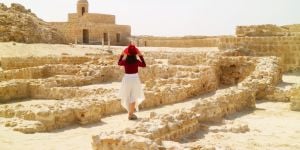
A successful move abroad generally involves having a better understanding of your new home from a historical point of view. For those who are passionate about history, going on an adventurous trip to discover historical sites and monuments will probably be a part of your plans. Before you get started, Expat.com gives you an insight into some of the countries with the richest histories.
Egypt

Land of huge deserts and impressive pyramids, crossed by the Nile, Egypt is known as the “Land of the Pharaohs”. Being the cradle of one of the world's most ancient civilisations, Egypt needs no introduction when it comes to history. Its monuments, architecture, and archeological sites speak for themselves. While being a highly regarded trade center due to its strategic location on the Mediterranean coast, Egypt has also been attracting visitors and expatriates in large numbers thanks to its historical and cultural heritage. The Sphinx standing in front of the Great Pyramids of Giza is one of the must-sees. Built around the year 2500 BCE, it is one of the world's biggest monolithic monumental sculptures, 3.5 meters long, 20.22 meters high and 14 meters wide. At the Coptic Museum and the Egyptian Museum, you will be delighted to find ancients relics of the Egyptian civilisation. Cairo and Alexandria are two of the most ecclectic Egyptian cities with their historical neighbourhoods, old traditional markets, not to mention their amazing architecture.
Italy

Italy's history goes back to the Roman Empire from thousands and thousands of years ago. Located in Central Europe, Italy has been attracting over 40 million visitors every year thanks to its huge historical heritage with a glimpse of ancient Shardan, Etruscan, and Latin cultures. The creation of the Roman Empire is deemed to be one of the major pillars of what is today considered as the cradle of Western culture. The Colosseum, for example, is a beautiful portrait of what remains of the Roman Empire. Now in ruins, it used to be the biggest amphitheater build during that era. Pompei is a UNESCO World Heritage Site built more than two thousand years ago and showcases the ancient Roman lifestyle. The Leaning Tower of Pisa is another world-famous emblematic site. Yet another UNESCO World Heritage Site, St. Peter's Basilica is the world's most significant religious building for Catholicism, designed by famous architects such as Michelangelo. In Siena, Piazza del Campo is a huge shell-shaped plaza with Italy's second biggest medieval tower.
Greece

A young and independent nation, Greece is one of the world's oldest civilisations where democracy existed since the very first Olympic Games era. Famous for its idyllic beaches and beautiful mountainous landscapes, Greece also has a great cultural and historical heritage as evident by its magnificent architecture. Located in the heart of Athens, the capital city, the Acropolis Rock is an archeological site that attracts thousands of visitors every year. From the Acropolis, you also get to see other sites such as the Parthenon, the Temple of Athena, and the Propylaea. The theaters of Dionysus and Herodes Atticus, the temple of Olympian Zeus, and the ancient Agora are some of the monuments you can contemplate at the Acropolis. Plaka, Philopappos, Monastiraki, and Thissio are the oldest neighbourhooods of Athens. At the foot of Mount Parnassus, Delphi is an ancient city known as the “center of the world”. It is a vast archaeological site where you can find ruins of an ancient temple of Apollo, the God of light. Sounio is where you can find an impressive temple of Poseidon, the Olympia which is the cradle of the Olympic Games, and Mycenae which is a huge sanctuary where stands the famous Lioness Gate.
China

Nicknamed the “Middle Kingdom”, China has become an attractive destination for expatriates, not only for its economic dynamism and prosperity but also for its impressive cultural heritage. China is indeed a country where ancient traditions meet modernity in complete harmony. Crossing the mountainous landscapes, including Beijing the capital city, the Great Wall is a world famous historical site built nearly 2300 years ago to protect the Chinese empire from invasions. The Forbidden City, also found in Beijing, used to be an imperial palace under the reign of 24 emperors from the Ming and Qing dynasties. Stretching over 7.2 hectares of land, the Forbidden City is the world's biggest monumental complex, reflecting the unparalleled beauty of the Chinese traditional architecture. In Xi'An, the Teracotta Army, stretching over 22,780 square meters, is a must-see. Batalllions of the first emperor under the Qin Dynasty, including 8,000 life-size soldiers and 10,000 bronze weapons were burried. A UNESCO World Heritage Site in Beijing, the Summer Palace is the country's biggest imperial garden.
Spain

Admired for its splendid beaches, pleasant climate, and affordable cost of living, Spain is much more than just a picture-perfect postcard with gorgeous landscapes. While the country owes its reputation to its quality of life and unparalleled cuisine, it still has a lot to teach about its history. It's interesting to note that the Kingdom of Spain, founded in 1492, results from the union of many independent kingdoms. If you've moving to Granada, the Alhambra is an amazing complex with gardens and buildings from the Nasrid dynasty era that used to be the political and aristocratic center of the Muslim West. A magnificent representation of the Spanish Gothic Art built from 1221 to 1765, Burgos Cathedral is a UNESCO World Heritage Site. In Andalusia, you should definitely not miss the Pont Neuf which divides Ronda into two. The central arch, now a museum, used to be a prison during the Civil War. Sevilla, for its part, includes many historical neighbourhoods with Santa Cruz at the heart of the city. The Alcázar, the Archiepiscopal Palace, and the Casa Lonja which is the General Archives of the Indies museum, are some of the historical constructions built in the Middle Ages.
Sources:



















